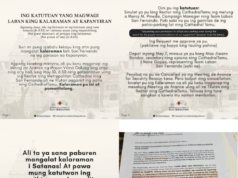ANGELES CITY- Families in two barangays in Botolan, Zambales will have to permanently give up their homes as the Department of Public Works and Highways (DPWH) has asserted that rechanneling the Bucao River away from their area would be a waste of time and money.
Central Luzon police director Chief Supt. Nilo de la Cruz, regional chairman of the Regional Disaster Coordinating Council (RDCC), told Punto during the weekend this was revealed to him by Public Works Sec. Hermogenes Ebdane who decided to “let nature take its course” in Barangays Carael and Paco in Botolan where the Bucao River continues to flow through their submerged homes since two months ago towards the South China Sea.
Zambales Provincial Disaster Coordinating Council (PDCC) executive director Graciela Macabare said that 845 families residing in Carael and another 820 families in Paco have remained in evacuation centers along Tarlac Road in Barangay Taugtog since the flow of the Bucao River diverted to their barangays towards the South China Sea during heavy rains last August.
But Macabare expressed surprise over De la Cruz’s revelation on plans to abandon the two barangays to Bucao River’s flow. “We have not been told anything about that,” she said.
Last August, strong currents from the Bucao River collapsed a dike and flowed through Carael and Paco. The dike was later repaired a few days later, but only to give way for the river to flow towards the same areas.
“Experts have determined it is no longer prudent to reconstruct the curving flow of the Bucao River towards the sea and allow it instead its present straight path since this seems to be its natural flow,” De la Cruz said.
He noted that the old bridge over Bucao River in Carael now stands on dry land as the river has sought new path in the two barangays.
Macabare cited claims of older folk in Botolan that Carael and Paco used to be part of the Bucao River channel.
She said that many residents of the two barangays have already dismantled their homes to reconstruct new ones in Barangay Taugtog where a “tent city” for the evacuees rose during the floods last August.
Macabare said Barangays Batonlapon and Paudpod, also in Botolan, were the ones initially hit earlier this year by strong currents from the Bucao River when a portion of the San Juan dike gave way. Last August, however, the collapse of another portion of the dike hit Carael and Paco instead.
“A total of 313 families from Batonlapok and another 407 families from Paudpod have not totally abandoned their homes since flashfloods from Bucao River readily recede in their areas, unlike in Carael and Paco where the flow has not ceased for two months now,” she noted.
Macabare said that as of yesterday morning, the submerged highway in Carael towards northern Zambales towns remained passable even to light vehicles, but she said waters were expected to rise amid expected rains to be triggered by storm Pepeng.
The Bucao River is also one of the tributaries emanating from the slopes of Mt. Pinatubo. It used to be an active lahar channel after Pinatubo’s eruption in 1991. A two-kilometer wide lake created by the eruption on its crater is drained through a “notch” on the crater wall towards the Bucao River towards the South China Sea.
Central Luzon police director Chief Supt. Nilo de la Cruz, regional chairman of the Regional Disaster Coordinating Council (RDCC), told Punto during the weekend this was revealed to him by Public Works Sec. Hermogenes Ebdane who decided to “let nature take its course” in Barangays Carael and Paco in Botolan where the Bucao River continues to flow through their submerged homes since two months ago towards the South China Sea.
Zambales Provincial Disaster Coordinating Council (PDCC) executive director Graciela Macabare said that 845 families residing in Carael and another 820 families in Paco have remained in evacuation centers along Tarlac Road in Barangay Taugtog since the flow of the Bucao River diverted to their barangays towards the South China Sea during heavy rains last August.
But Macabare expressed surprise over De la Cruz’s revelation on plans to abandon the two barangays to Bucao River’s flow. “We have not been told anything about that,” she said.
Last August, strong currents from the Bucao River collapsed a dike and flowed through Carael and Paco. The dike was later repaired a few days later, but only to give way for the river to flow towards the same areas.
“Experts have determined it is no longer prudent to reconstruct the curving flow of the Bucao River towards the sea and allow it instead its present straight path since this seems to be its natural flow,” De la Cruz said.
He noted that the old bridge over Bucao River in Carael now stands on dry land as the river has sought new path in the two barangays.
Macabare cited claims of older folk in Botolan that Carael and Paco used to be part of the Bucao River channel.
She said that many residents of the two barangays have already dismantled their homes to reconstruct new ones in Barangay Taugtog where a “tent city” for the evacuees rose during the floods last August.
Macabare said Barangays Batonlapon and Paudpod, also in Botolan, were the ones initially hit earlier this year by strong currents from the Bucao River when a portion of the San Juan dike gave way. Last August, however, the collapse of another portion of the dike hit Carael and Paco instead.
“A total of 313 families from Batonlapok and another 407 families from Paudpod have not totally abandoned their homes since flashfloods from Bucao River readily recede in their areas, unlike in Carael and Paco where the flow has not ceased for two months now,” she noted.
Macabare said that as of yesterday morning, the submerged highway in Carael towards northern Zambales towns remained passable even to light vehicles, but she said waters were expected to rise amid expected rains to be triggered by storm Pepeng.
The Bucao River is also one of the tributaries emanating from the slopes of Mt. Pinatubo. It used to be an active lahar channel after Pinatubo’s eruption in 1991. A two-kilometer wide lake created by the eruption on its crater is drained through a “notch” on the crater wall towards the Bucao River towards the South China Sea.



